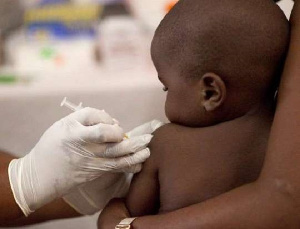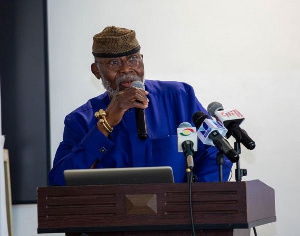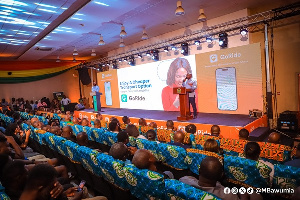 Community Health officers say they are faced with challenges
Community Health officers say they are faced with challenges
Correspondence from Eastern Region
• Health workers in Asutifi North Municipality have listed a number of challenges they go through
• Nurses involved in malaria vaccination have said that some communities are hard to reach
• They added that there are no vehicles to transport them to the communities in the Municipality
Community Health officers, including pregnant nurses, in the Asutifi North Municipality of the
Read full article.Ahafo Region, have decried the hectic journey and circumstances they have to go through to make the ongoing malaria vaccination exercise accessible to hard-to-reach communities.
According to the health workers, the deplorable nature of the road networks leading to those hard-to-reach communities coupled with the lack of adequate transport systems also makes contact-tracing efforts more discouraging, especially when it rains.
Speaking to GhanaWeb’s McAnthony Dagyenga at Kenyase in the Ahafo Region, the malaria focal person for the Asutifi North Municipality, Laar Salaam Dam-Park, narrated that the number of hard-to-reach communities in the Municipality was quite numerous, thus making their work difficult.
“We have hard-to-reach communities in the district. We are one of the districts with a sub-district that when you are going you have to cross two other districts. It is over 100km away from the District capital. That is called Gambia. You pass through Asutifi South and Asunafo North before you get to Gambia.
“In that place we have streams and rivers that when it rains, you cannot cross with your motorbike. A community like Yaa Beneagya is under the Gambia sub-district. Communities like Koware, Biaso, Kasapee; there is a river Bia around those areas so when it rains and it overflows its bounds, you cannot cross to do malaria vaccination.
“We also have communities in the Kenyase sub-district. We have the Yaro Goma, Ananekrom which also have streams around that when it rains it is difficult to go to those areas to do CWC or go for home visits to do contact tracing.
“We also go to Gyedu sub-district, we have communities like Tentaa, Nincheama and Panaaba. We also have the Amoma river and some streams along the road so when it rains it is also difficult to go to those communities,” Dam-Park narrated.
According to Vera Dwamena, a pregnant Community Health Nurse stationed at Gambia, “We don’t have a straight car to Gambia. You will board a car from Kenyasi to Hwediem; Hwediem to Goaso; Goaso to Mim; and then from Mim to Gambia. It takes about three hours to get there from Kenyasi.
“Sometimes when you need something from the office you can hardly get it. If you need a syringe or anything to do your work, you cannot get it anywhere. Unless you come to board various cars before getting to the district capital to get it. You have made all this hectic journey to come to Kenyase to get it,” she expressed.
Joana Adobea Mensah, also a Community Health Nurse, narrated that “Our road network is bad especially when it rains. It is difficult reaching some of the clients in their homes for contact tracing.”
The Malaria Vaccination Implementation Programme, introduced in May 2019, has been ongoing in parts of the country on pilot basis. Currently, the piloting is taking place in 42 districts selected from seven regions of Ghana including the Asutifi North district of the Ahafo Region.
The malaria vaccine, also called RTS,S, is administered to eligible children who receive the vaccine at specified times from the age of 6 months, with the final dose given at 24 months (or two years) of age.
On attaining age 6 months, a parent sends her baby to the Child Welfare Clinic to be given the first dose of the RTS,S. The second dose is administered when the child is seven month old, the third dose is given when the child turns nine months old and the final and fourth dose given to the child at age two.
According to Dam-Park, the Municipal Malaria Focal Person, between 1st May to 31st December 2019, his outfit was supposed to vaccinate a total of 2,630 children.
“At the end, 65.9% of the children received RTS,S1, 56.7% received RTSS2 and 40.7% received RTSS3. Because it was the year the vaccine was introduced we had a lot of challenges getting parents to understand.
“In 2020, from 1st January to 31st December, we did 70.9% coverage for RTSS1, 71.9% for RTSS2 and 66.4% for RTSS3.
“First quarter 2021, RTSS1, we covered 18.8%, RTSS2 we achieved 18.7% and RTSS3, 17.9% with a dropout rate of 4.9% which is normal as a dropout rate is supposed to be between 0 to 10%. And RTSS4 we had 9.4% because it was somewhere in May that those who were given RTSS1 were due for the RTSS4,” he disclosed.
Mr. Dam-Park however expressed that despite the challenges in covering the hard-to-reach communities in the Asutifi North, there has been a satisfactory result gained since the malaria cases have seen a downward trend.
He said in 2018 the incident rate was 408 per 1000 and in 2019 it dropped to 358 and in 2020 it further dropped to 258 while emphasising that the number of malaria cases among children in the last two years has seen impressive reduction.
“We are making sure that all those children who have defaulted will be traced and given the missed doses. We have pulled the data and we know where the gaps are coming from and we are going to look for them so that by December our coverage will increase and the dropout rate will be reduced,” he stressed.











